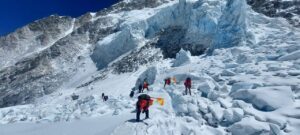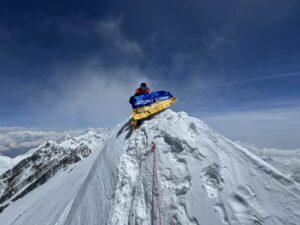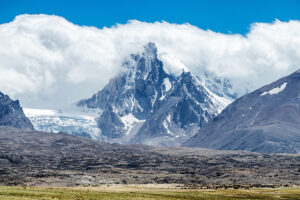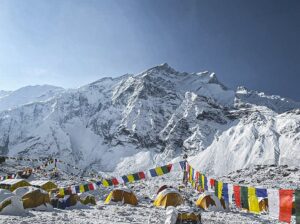Billi Bierling of the Himalayan Database describes the normal route up 8,047m Broad Peak, the 12th highest peak on Earth.

Broad Peak Base Camp, after a dusting of snow. Photo: Dani Arnold
According to many, Broad Peak is one of the easier 8,000’ers. Located opposite K2, with its Base Camp just a couple of hours away, climbers have recently used it as an acclimatization peak for K2. This way, they avoid partial rounds up and down the harder and more dangerous K2 before their summit push. It also gives them an opportunity to bag a second 8,000m peak.

Dean Staples on the glacier between Base Camp and the foot of Broad Peak. A truncated K2 looms in the background. Photo: Billi Bierling
“I wouldn’t say there is such thing as an ‘easy’ 8,000’er,” said Billi Bierling, who has summited six 8,000m peaks and is a senior member of the Himalayan Database. It took her two tries to succeed on Broad Peak. In 2015, she made it just to Camp 3. She finally summited in 2019. “It’s a mountain with hidden dangers and a bloody long summit day,” she said.
From Base Camp (4,850m) to Camp 1 (5,500m)
Broad Peak’s Base Camp lies just before K2’s. Access is via the Baltoro Glacier. “It’s a big place, usually on rocky ground (except if it snows), with stunning views of K2 in front and Laila Peak behind,” Bierling said.
One of the trickiest sections appears even before the base of the mountain.
“From BC (4,850m) to the beginning of the route, there is a one hour navigating across the glacier,” Bierling said. “It’s quite broken, difficult to find the way, unstable as it gets hotter, and ever-changing.”

A tricky glacier passage runs between BC and the foot of Broad Peak. Photo: Billi Bierling
“Then the route goes up mainly snowy ramps, whose difficulty varies greatly depending on conditions. A rocky face above you at your right releases rocks constantly, right at your head. You really want to go early, when the face is more stable, and run up.”
Bierling admits that had she not worn a helmet, she would not have survived. “It is definitely the most dangerous part of the entire climb.”

Before Camp 1. Photo: Billi Bierling
Avalanches can also come down if the face is overloaded. “A Japanese woman was injured by a slide there on my 2015 climb,” she said.
When you get to the top of the rocky section, the going eases until Camp 1. It lies on a small plateau at 5,500m, without room for many tents.

Camp 1 from above. Photo: Billi Bierling
Camp 2 (6,100m) and Camp 3 (approx. 7,100m)
Between C1 and C2, the route goes leftward up a mixed slope of snow and rock. “Then you go along a rock face to the left, including some steep gullies and passages. Luckily, Sherpas and Pakistani high-altitude porters had previously fixed them,” Bierling said. “I wouldn’t say technical, but indeed steep.”

Toward Camp 2. photo: Billi Bierling
Camp 2, at 6,100m, is not on a plateau but carved right into the slope. “It’s a good idea to clip into the rope if you need to get out of the tent,” she says. “You don’t want to slip there.”
Then on to Camp 3.
“We set it at 6,900m at the bottom of an increasingly narrow couloir that leads to the saddle by the summit ridge,” Bierling said. “Our camp was lower than usual because we were a big group. We later regretted it, because we had a super-long summit day. Gerlinde Kaltenbrunner told me that she had pitched hers at nearly 7,200m. This makes lots of sense, considering that my summit push the following day lasted over 30 hours.”

Climbers set off from Camp 3 toward the summit. Photo: Billi Bierling
Early departure and the two sides of O2
“Knowing it would be a long day, we set off at 6 pm [the night before],” Bierling recalls. “In fact, it’s not such a bad idea to leave at that hour: It spares you the terrible struggle I always have getting up when the alarm goes off at midnight. You have to peel yourself out of your sleeping bag and go out to the bitter cold night. At 6 pm, it’s still sunny!”
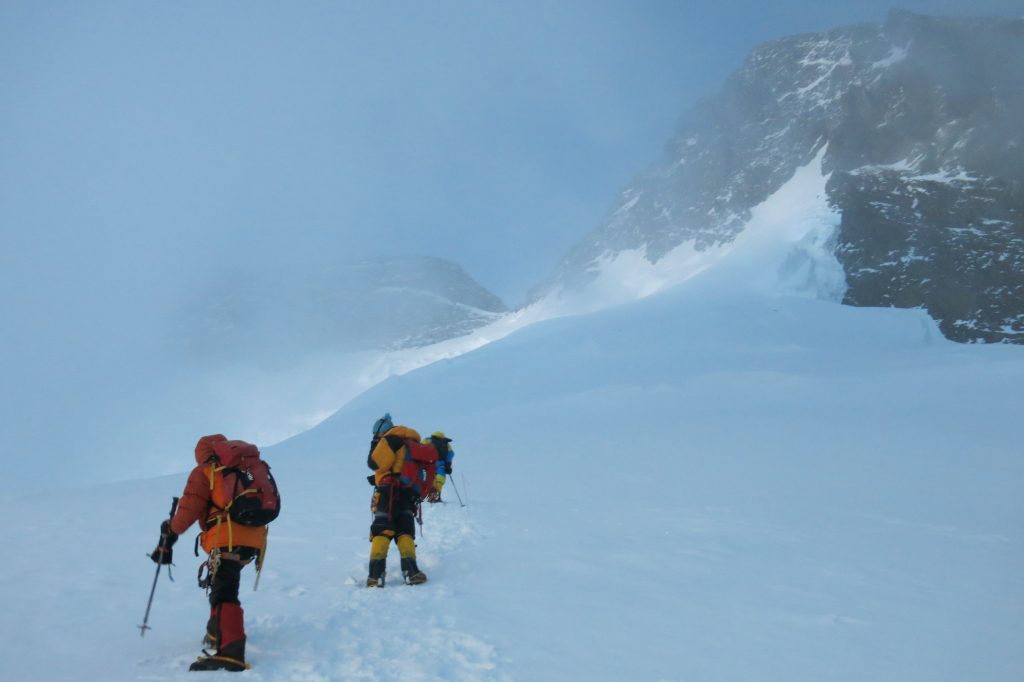
Climbers approach the saddle. Photo: Billi Bierling
“Had I used supplementary oxygen, I wouldn’t have summited,” Bierling admits. There is a reason for this: In Nepal, climbers rely on plenty of Sherpa support. In the Karakorum, everyone has to carry their own oxygen bottles, which are rather heavy.
“Some people in our team were using O2 and they were carrying 2 bottles,” Bierling explained. “Each bottle weighs 4.5kg. So two bottles plus the regulator and water and all you need add up to 11 or 12kg. I am not strong, and on such an extremely long day, I couldn’t have made it to the summit.”
Besides, in order to make those two bottles last, the climbers cannot have a flow rate of more than one or two litres per minute, which isn’t much.
“It doesn’t make sense on a low 8,000’er like Broad Peak,” she says.

On the summit ridge, at the top of the gully. Photo: Billi Bierling
The summit ridge
From Camp 3, climbers move toward the saddle at about 7,600m. “That’s where I stopped in 2015 because that slope is very avalanche-prone and we found it really overloaded,” Bierling said.
In better conditions, as in 2019, the route continues until the saddle and the summit ridge. “The crux to me was the last 50-60 vertical metres leading to the saddle. A narrowing slope turns into a gully where the rocks are covered with ice, not snow. Again, we had fixed rope,” Bierling said.
She estimates that her team reached the summit right after dawn, some 10 hours after leaving C3.

Mixed terrain on Broad Peak’s summit ridge, shortly before the foresummit. Photo: Billi Bierling
The summit ridge features undulating terrain with a mix of rock and snow. “There is this short rocky passage near the summit where you have to do some awkward move,” she said. “You have to stand on the other side of the ridge, and then traverse back.”
She had fixed rope on that section too, so it didn’t feel unsafe. The ridge alternates with rock, snow, windswept cornices, and becomes wider and narrower by turns until the foresummit.

Broad Peak’s main summit, as seen from the foresummit. Photo: Billi Bierling
Here, mental preparation helps. At the foresummit, the ridge descends, then climbs again to the real summit.
“Just the thought of losing altitude and then having to gain it again — and do the reverse way on the way back — is enough to discourage many climbers,” she said. “Two in our team said that they had had enough and stopped at the foresummit. After such a long day, having to climb even that little extra bump is exhausting.”
She adds that it takes about an hour to get from the foresummit to the real summit. “It was easier I thought it would be,” she said. “I don’t remember a fixed rope there.”

Billi Bierling looking quite fresh after 15 hours climbing, on Broad Peak’s (real) summit.
Overall, Bierling says that Broad Peak is not a technical mountain. “I never felt afraid of something really difficult ahead, but that’s because a Sherpa-Pakistani team had been there before us, fixing ropes. Otherwise, I would not have summited, honestly.”
Adds Bierling: “It’s like Everest: People say it’s technically easy but hey, I would like to see everyone going up the Lhotse Face with no ropes!”
The descent from Broad Peak seemed to take forever, Bierling recalls.
“I was so exhausted, I didn’t abseil but arm-wrapped down most of the ropes. I also made the same mistake I usually do of not drinking enough, and I paid the price.”
Nevertheless, she made it down. “I was so, so happy, so proud that I had made it,” she said. “I was actually not that tired on the summit, and I was faster than some people on O2. In Camp 3, I had thought there was no possible way I could reach the summit because it was so bloody far! And yet I made it, I made it! It was one of the happiest moments of my life.
“Last but not least, I had the privilege of climbing a mountain with a full view of K2 in front of me all the time: That magical mountain that I will never climb, and all those beautiful peaks around it. I always find myself transported back there when I speak about it!”

Bierling, back at Camp 1.
Bierling summited Broad Peak on July 14, 2019. She and her team wrote their original summit account here.

